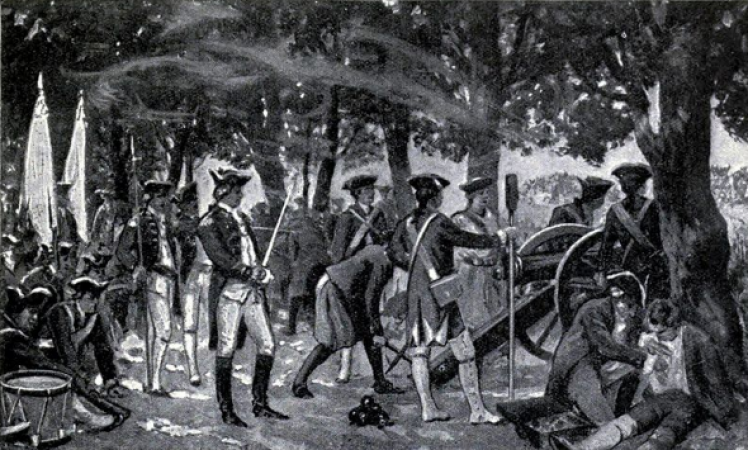
New Delhi: The Battle of Plassey was a significant historical event that took place on June 23, 1757, in the region of Bengal, which is now part of present-day India and Bangladesh. It was a decisive battle between the forces of the British East India Company, led by Robert Clive, and the army of the Nawab of Bengal, Siraj ud-Daulah.
During the mid-18th century, the British East India Company had established several trading posts and factories along the eastern coast of India. However, they faced increasing challenges from the local rulers, including the Nawab of Bengal, who sought to assert his authority and control over the Company's activities.
The conflict between the East India Company and the Nawab escalated, and in 1756, Siraj ud-Daulah captured the British trading post of Fort William in Calcutta (now Kolkata) and imprisoned several Company officials in a small, overcrowded room known as the Black Hole of Calcutta. Many of the imprisoned officials died due to suffocation and heat.
Also Read: France Unleashes 'Operation Unity Shield': A NATO-Backed Truce Plan to Secure Peace in Ukraine
In response to this incident, the British sent forces under the command of Robert Clive to recapture Calcutta and seek retribution. Clive managed to retake Calcutta and, with the support of local allies, including Mir Jafar, a disgruntled general in the Nawab's army, he planned to confront Siraj ud-Daulah's forces at Plassey.
The battle itself was not a large-scale conflict but was rather a strategic maneuver. Clive's forces were significantly outnumbered, with around 3,000 soldiers against Siraj ud-Daulah's army of 50,000. However, Clive managed to exploit divisions within the Nawab's camp and secure the support of Mir Jafar, who had secretly agreed to betray the Nawab during the battle.
On the day of the battle, Clive's forces engaged with the Nawab's army. Mir Jafar and his troops, as planned, switched sides and effectively turned the tide of the battle in favor of the British. The Nawab's forces were defeated, and Siraj ud-Daulah himself fled the battlefield. The British East India Company emerged victorious, securing control over Bengal and marking the beginning of British dominance in the Indian subcontinent.
The Battle of Plassey had far-reaching consequences. It established the East India Company as a significant political and military power in India. It also paved the way for subsequent British conquests and laid the foundation for the establishment of British colonial rule in India, which lasted for nearly two centuries until India gained its independence in 1947.
Mistakes in battle of plassey:
While the Battle of Plassey is considered a decisive victory for the British East India Company, there were several mistakes and controversies associated with the battle. Here are some notable ones:
Miscommunication and misunderstanding: The Nawab of Bengal, Siraj ud-Daulah, received conflicting advice from his commanders and advisers, which led to confusion and a lack of a unified strategy. There were disagreements on how to engage the British forces, and this internal disarray weakened the Nawab's position.
Betrayal of Siraj ud-Daulah: One of the critical factors in the British victory was the betrayal of Siraj ud-Daulah by Mir Jafar, a general in the Nawab's army. Mir Jafar, motivated by personal ambition and promises of rewards from the British, secretly conspired with Robert Clive and switched sides during the battle. This betrayal significantly weakened the Nawab's forces and contributed to their defeat.
Limited battlefield intelligence: The British forces had limited knowledge of the terrain and the strength of the Nawab's army. They relied on information from local informants and spies, which was not always accurate. However, the British were able to exploit divisions within the Nawab's camp and capitalize on the element of surprise.
Numerical disadvantage: The British forces were significantly outnumbered by the Nawab's army. The Nawab had around 50,000 soldiers compared to Clive's force of approximately 3,000 troops. Despite this numerical disadvantage, the British were able to secure victory due to the factors mentioned earlier, such as betrayal and internal divisions among the Nawab's forces.
Also Read: In Romania, Andrew Tate is accused of rape and human trafficking
Weather conditions: Heavy rainfall and monsoon season affected the battlefield and made it difficult for the larger Nawab's army to maneuver effectively. The rain also affected the performance of the Nawab's artillery, giving the British an advantage.
It's important to note that while these factors played a role in the outcome of the Battle of Plassey, the battle itself was not solely determined by mistakes.
The strategic planning, manipulation of alliances, and tactical maneuvering by the British East India Company were also significant factors in their victory.